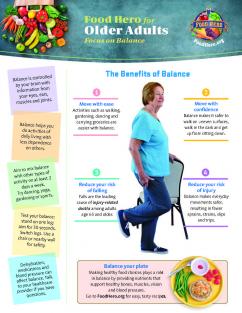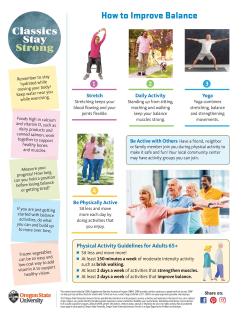Focus on Balance
The Benefits of Balance
- Move with ease. Activities such as walking, gardening, dancing and carrying groceries are easier with balance.
- Move with confidence. Balance makes it safer to walk on uneven surfaces, walk in the dark and get up from sitting down.
- Reduce your risk of falling. Falls are the leading cause of injury-related deaths among adults age 65 and older.
- Reduce your risk of injury. Balance makes everyday movements safer, resulting in fewer sprains, strains, slips and trips.
More about Balance
- Balance is controlled by your brain with information from your eyes, ears, muscles and joints.
- Balance helps you do activities of daily living with less dependence on others.
- Aim to mix balance with other types of activity on at least 2 days a week. Try dancing, yoga, gardening or sports.
- Test your balance: stand on one leg; aim for 30 seconds. Switch legs. Use a chair or nearby wall for safety.
- Dehydration, medications and blood pressure can affect balance. Talk to your healthcare provider if you have questions.
Balance your plate
Making healthy food choices plays a role in balance by providing nutrients that support healthy bones, muscles, vision and blood pressure. Go to FoodHero.org for easy, tasty recipes.
How to Improve Balance
- Stretch: Stretching keeps your blood flowing and your joints flexible.
- Daily Activity: Standing up from sitting, reaching and walking keep your balance muscles strong.
- Yoga: Yoga combines stretching, balance and strengthening movements.
- Be Physically Active: Sit less and move more each day by doing activities that you enjoy.
Be Active with Others: Have a friend, neighbor or family member join you during physical activity to make it safe and fun! Your local community center may have activity groups you can join.
Classics Stay Strong
- Remember to stay hydrated while moving your body! Keep water near you while exercising.
- Foods high in calcium and vitamin D, such as dairy products and canned salmon, work together to support healthy bones and muscles.
- Measure your progress! How long can you hold a position before losing balance or getting tired?
- Be active with others. Have a friend, neighbor or family member join you during physical activity to make it safe and fun! Your local community center may have activity groups you can join.
- If you are just getting started with balance activities, do what you can and build up to more over time.
- Frozen vegetables can be an easy and low-cost way to add vitamin A to support healthy vision.
Physical Activity Guidelines for Adults 65+
- Sit less and move more!
- At least 150 minutes a week of moderate intensity activity such as brisk walking.
- At least 2 days a week of activities that strengthen muscles.
- At least 2 days a week of activities that improve balance.




